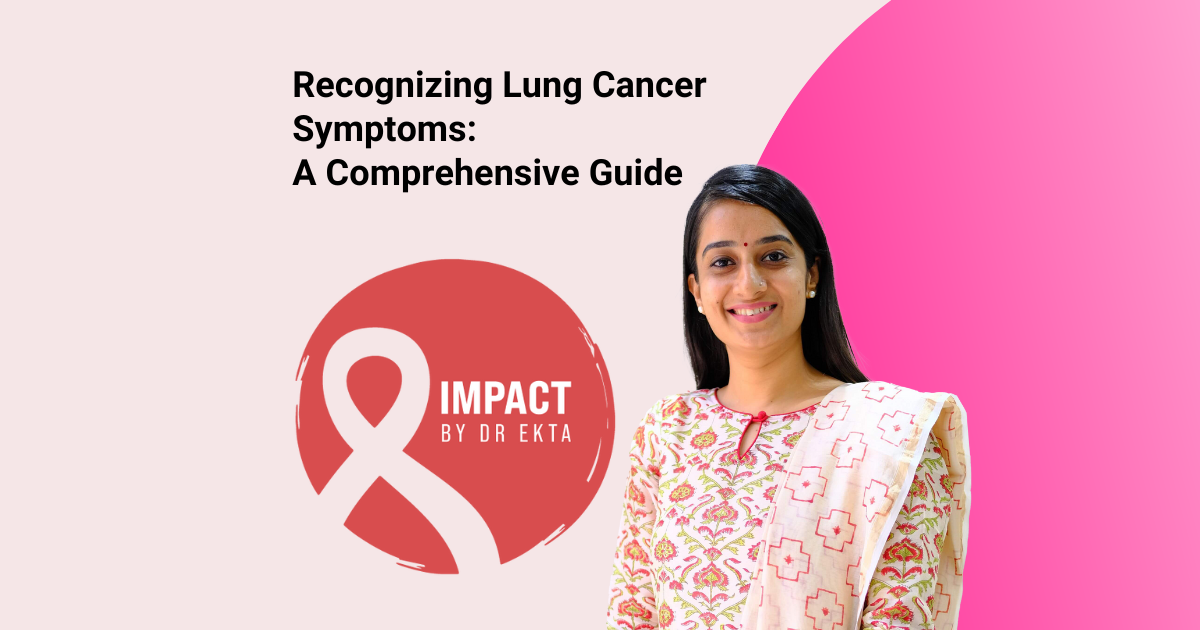Understanding Lung Cancer
As an Oncologist, it’s important to dig into a topic that is of utmost importance. Do you know According to a 2022 study published in the Indian Journal of Medical Research, India may see a seven-fold increase in lung cancer cases by 2025, with over 161,000 cases, including 81,000 in men and 30,000 in women. Lung cancer is one of the most common and deadliest forms of cancer worldwide. Early detection of lung cancer symptoms can significantly improve treatment outcomes and survival rates. This comprehensive guide aims to help you recognize the early signs and symptoms of lung cancer, understand the importance of timely medical consultation, and highlight risk factors and diagnostic methods.
Lung cancer originates in the lungs, where cells grow uncontrollably, leading to the formation of tumors. These tumors can impair lung function and spread to other parts of the body. Lung cancer is broadly categorized into two types: non-small cell lung cancer (NSCLC) and small cell lung cancer (SCLC). Each type progresses differently and requires distinct treatment approaches.
Common Lung Cancer Symptoms
Recognizing lung cancer symptoms early is crucial for effective treatment. Here are some of the most common symptoms:
1. Persistent Cough
A chronic cough that lasts for more than a few weeks is often one of the first lung cancer symptoms. If you notice a persistent cough that doesn’t go away or worsens over time, it’s essential to consult a healthcare professional.
2. Chest Pain
Chest pain that is constant and may worsen with deep breathing, coughing, or laughing can be a symptom of lung cancer. The pain might be localized or spread across the chest area.
3. Shortness of Breath
Difficulty in breathing or shortness of breath can be a sign of lung cancer, especially if it occurs without exertion. This symptom can result from the tumor blocking airways or fluid accumulating around the lungs.
4. Unexplained Weight Loss
Sudden and unexplained weight loss is another potential lung cancer symptom. If you notice significant weight loss without changes in diet or physical activity, it’s worth discussing with your doctor.
5. Hoarseness
Changes in your voice, such as hoarseness or a raspy voice, can indicate lung cancer. This occurs when the tumor affects the nerves controlling the vocal cords.
6. Blood in Sputum
Coughing up blood or rust-colored sputum is a concerning lung cancer symptom that requires immediate medical attention. Even a small amount of blood can be indicative of a serious condition.
7. Fatigue
Persistent fatigue that doesn’t improve with rest can be a symptom of lung cancer. This general feeling of tiredness can affect daily activities and overall quality of life.
8. Frequent Lung Infections
Recurring infections such as bronchitis or pneumonia can be linked to lung cancer. Tumors can obstruct airways, making it easier for infections to develop.
Less Common Lung Cancer Symptoms
While the above symptoms are more common, some individuals may experience less typical lung cancer symptoms. These include:
1. Shoulder or Arm Pain
Pain that radiates to the shoulder or arm can sometimes be associated with lung cancer, particularly if the tumor is located at the top of the lung (Pancoast tumor).
2. Swelling in the Face or Neck
Swelling of the face, neck, or arms can occur due to lung cancer obstructing blood flow in the veins near the lungs.
3. Difficulty Swallowing
Tumors pressing on the esophagus can cause difficulty swallowing, a condition known as dysphagia.
4. Clubbing of Fingers
Clubbing, a condition where the fingertips become rounded and the nails curve over them, can be one of the lung cancer symptoms
Risk Factors for Lung Cancer
Certain factors can increase the risk of developing lung cancer:
1. Smoking
Smoking is the leading cause of lung cancer, responsible for approximately 85% of cases. The risk increases with the number of cigarettes smoked and the duration of smoking.
2. Exposure to Radon Gas
Radon, a naturally occurring radioactive gas, can accumulate in homes and buildings. Prolonged exposure to high levels of radon increases the risk of lung cancer.
3. Occupational Hazards
Exposure to carcinogens such as asbestos, arsenic, and diesel exhaust in the workplace can elevate the risk of lung cancer.
4. Family History
A family history of lung cancer can increase an individual’s risk, suggesting a potential genetic predisposition.
5. Previous Radiation Therapy
Individuals who have undergone radiation therapy to the chest for other cancers may have a higher risk of developing lung cancer.
Diagnostic Methods for Lung Cancer
Early diagnosis of lung cancer symptoms can significantly improve treatment outcomes. Here are some common diagnostic methods:
1. Imaging Tests
Chest X-rays, CT scans, and PET scans are commonly used to detect abnormalities in the lungs. These imaging tests can reveal tumors, enlarged lymph nodes, and other signs of lung cancer.
2. Sputum Cytology
Examining sputum under a microscope can help identify cancerous cells. This test is particularly useful for detecting lung cancer in individuals with a persistent cough.
3. Biopsy
A biopsy involves taking a sample of lung tissue to examine for cancer cells. Methods include bronchoscopy, needle biopsy, or surgical biopsy, depending on the tumor’s location.
4. Blood Tests
While blood tests alone cannot diagnose lung cancer, they can provide information about overall health and help identify potential markers for cancer.
Conclusion
Recognizing lung cancer symptoms early and seeking prompt medical attention can make a significant difference in the prognosis and treatment of the disease. Persistent cough, chest pain, shortness of breath, unexplained weight loss, hoarseness, blood in sputum, fatigue, and frequent lung infections are key symptoms to watch for. Additionally, understanding risk factors such as smoking, radon exposure, occupational hazards, family history, and previous radiation therapy can help in early identification and prevention.
If you experience any lung cancer symptoms, consult your healthcare provider for further evaluation. Early detection and timely intervention are critical in the fight against lung cancer, potentially saving lives and improving the quality of life for those affected. Stay informed, stay vigilant, and prioritize your health.

